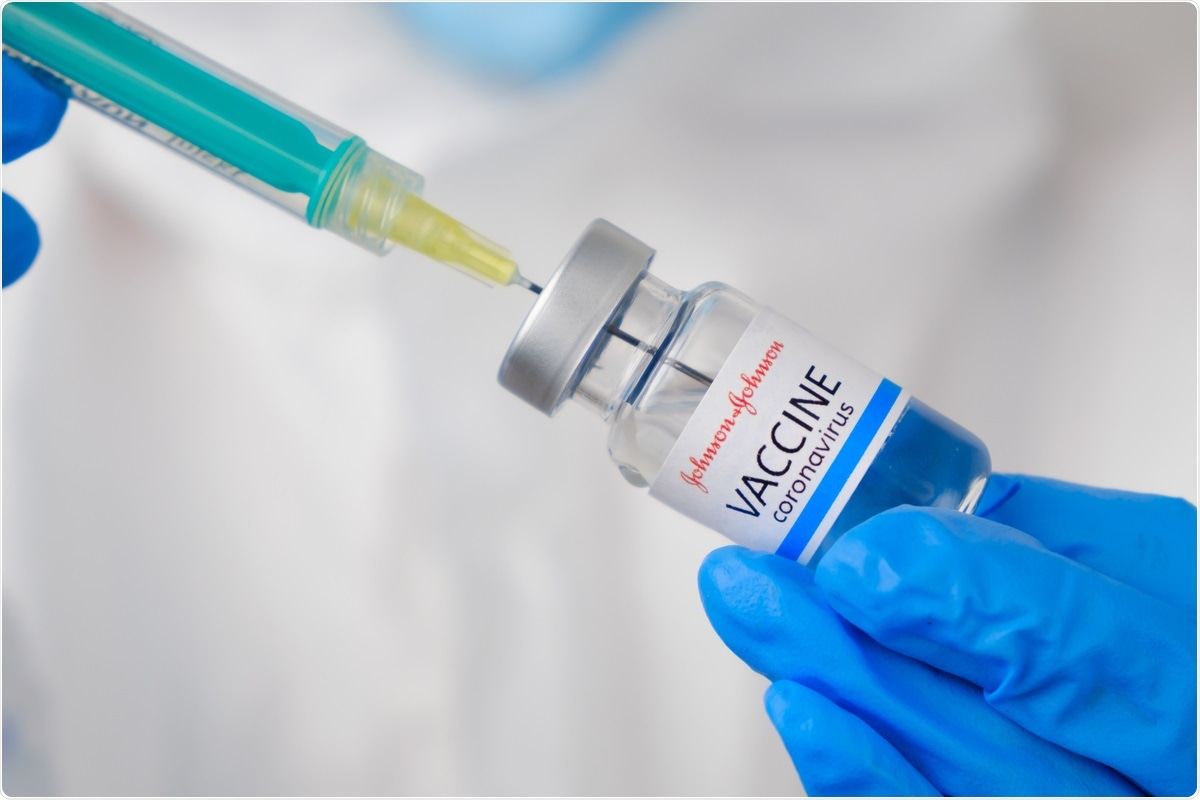Vaccination has been the key strategy to reduce the incidence of severe acute respiratory syndrome coronavirus 2 (SARS-CoV-2) infection and protect from severe coronavirus disease 2019 (COVID-19) worldwide. Accelerated vaccine development efforts leveraged the approval of SARS-CoV-2 vaccines that displayed varying clinical efficacy. The highest efficacy was associated with the adenoviral vector and mRNA-based vaccines.
 Study: Differential immunogenicity of homologous versus heterologous boost in Ad26.COV2.S vaccine recipients. Image Credit: Vladimka production/ Shutterstock
Study: Differential immunogenicity of homologous versus heterologous boost in Ad26.COV2.S vaccine recipients. Image Credit: Vladimka production/ Shutterstock
Vaccine-induced protective efficacy is associated with their ability to induce neutralizing anti-spike antibodies and spike-specific T cells. The appearance of variants of concern like the recent Delta variant and the progressive waning of antibody titers observed over time has reduced the protective efficacy of COVID-19 vaccines. These findings have highlighted the need for possible booster vaccinations.
Ad26.COV2 (Johnson & Johnson) is a single-dose vaccine with protective efficacy against severe disease. A single immunization with Ad26.COV2.S induced rapidly cellular immune responses as well as binding and neutralizing antibodies, including induction of Receptor Binding Domain (RBD)-specific binding antibodies in 90% of vaccine recipients
However, there has been evidence of a higher incidence of breakthrough infections with the Delta variant among those inoculated with a single dose of Ad26.COV2.S, in comparison to mRNA vaccinated in some U.S. states.
Additionally, a reduced ability of Ad26.COV2.S to induce humoral immune has also been reported in immunocompromised individuals. As a result, a second dose, similar to the double-dose regimen recommended for mRNA-based vaccines (Pfizer BNT162b2 and Moderna mRNA1273) and the adenoviral vector-based vaccine (Astrazeneca ChAdOx1 nCov-19), has been proposed for individuals receiving Ad26.COV2.S.
Reports of studies done in animal models and healthy individuals vaccinated with the other adenoviral vector-based vaccine, ChAdOx1 nCov19, followed by BNT162b2, have shown a heterologous vaccine boost enhances both cellular and humoral immunity. Data recently reported showed an ability of both homologous and heterologous boost after Ad26.COV2.S to increase spike-specific antibodies. However, a parallel analysis for cellular immunity was not performed.
Researchers from Singapore thus conducted a study to assess the spike protein-specific humoral and cellular immunity in Ad26.COV2.S vaccinated individuals either primed with Ad26.COV2.S only, or boosted with a homologous (Ad26.COV2.S) or heterologous (BNT162b2 by Pfizer) second dose. This study was published in the pre-print server medRxiv* and is currently under peer review.
Study details
Researchers investigated cellular and humoral immune responses in samples from 115 participants who had received single and double doses of both homologous and heterologous vaccines (Ad26.COV2.S and BNT162b2). They studied 10 to 22 unvaccinated healthy individuals and 40 unvaccinated SARS-CoV-2 convalescents as controls for the study.
In the homologous double dose Ad26.COV2.S cohort, the median time between the first and second doses was 56 days (the overall range was 43- 71 days).
In the heterologous switch dose Ad26.COV2.S and BNT162b2 cohort, the median number of days between first and second dose was 31 days, but with a wider overall range (11-180 days). The time between the first and second dose of BNT162b2 was 21 days (21-104 days).
Researchers found that a booster shot increased the overall profile of humoral immune responses in all individuals irrespective of their first vaccination, both qualitatively and quantitatively. Quantitative analysis showed that individuals were vaccinated with Ad26.COV2.S both homologous (J+J) and heterologous (J+P) vaccination increased the quantity of total spike IgG and neutralizing antibodies (sVNT).
However, heterologous (J+P) vaccination-induced more anti-spike IgG and IgA antibodies than homologous (J+J) vaccination. The level of neutralizing antibodies was also higher in heterologous versus homologous vaccinated individuals, even though it did not reach statistical significance. The key takeaway in this study was that all heterologous vaccinated individuals (9/9) had neutralizing antibodies that achieved more than 80% of inhibition in the sVNT. In contrast, 7/21 of homologous vaccinated (J+J) had sVNT levels below 50%.
The analysis of spike-specific T cells showed a higher frequency in heterologous (J+P) versus homologous (J+J) vaccine recipients. This was similar to the level observed in individuals receiving double doses of BNT161b2.
Qualitatively, the ability to produce a polyclonal antibody response targeting different regions of the spike protein is essential to maintain the protective efficacy of humoral immunity against SARS-CoV-2 variants. Similarly, T cell responses targeting multiple spike sites will reduce the chances of viral variants escaping T cell recognition and host immune surveillance.
Thus, researchers analyzed the qualitative aspects of humoral and cellular immunity induced by the different vaccination strategies. Antibodies (IgG and IgA) against the S1 (containing RBD) and the S2 regions of the spike protein were quantified. Homologous or single-dose BNT162b2 vaccination elicited antibodies targeting both chains of spike protein, while Ad26.COV2.S vaccination mounted an antibody response targeting the S1 chain preferentially.
However, heterologous (J+P) vaccination broadened the antibody repertoire against spike since all the heterologous vaccinated individuals (9/9) had antibodies against both domains, while only 2/23 of homologous (J+J) vaccinated individuals displayed such antibody diversity.
Additionally, both homologous (J+J; P+P) and heterologous (J+P) booster vaccination increased the proportion of class-switched spike-specific memory B cells (MBCs) in comparison to a single dose of Ad26.COV2.S (J) or BNT162b2 (P). Class-switched memory B cells can help in increasing the longevity of humoral immune responses, thus increasing vaccination efficacy.
Study implications
This study highlights the positive effect of booster doses, and most importantly, heterologous booster doses, which has been a topic of immense research in the present scenario. Though the immunological correlates of protection induced by the vaccines are still only hypothesized, the data can be immensely useful and encouraging in entailing more studies with different vaccines and help in combating vaccine shortage globally.
*Important notice
medRxiv publishes preliminary scientific reports that are not peer-reviewed and, therefore, should not be regarded as conclusive, guide clinical practice/health-related behaviour, or treated as established information
- Kim Huat, N. et al. (2021) "Differential immunogenicity of homologous versus heterologous boost in Ad26.COV2.S vaccine recipients". medRxiv. doi: 10.1101/2021.10.14.21264981.
Posted in: Medical Science News | Medical Research News | Disease/Infection News
Tags: Antibodies, Antibody, Cell, Coronavirus, Coronavirus Disease COVID-19, Efficacy, Frequency, Homologous, immunity, Immunization, Polyclonal Antibody, Protein, Quantitative Analysis, Receptor, Research, Respiratory, SARS, SARS-CoV-2, Severe Acute Respiratory, Severe Acute Respiratory Syndrome, Spike Protein, Syndrome, Vaccine

Written by
Sreetama Dutt
Sreetama Dutt has completed her B.Tech. in Biotechnology from SRM University in Chennai, India and holds an M.Sc. in Medical Microbiology from the University of Manchester, UK. Initially decided upon building her career in laboratory-based research, medical writing and communications happened to catch her when she least expected it. Of course, nothing is a coincidence.
Source: Read Full Article
